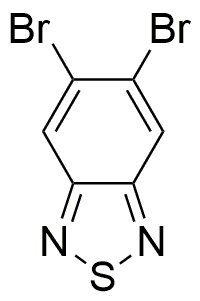5,6-Dibromo-2,1,3-benzothiadiazole is widely utilized in research focused on:
- Organic Electronics: This compound is used in the development of organic semiconductors, which are essential for creating flexible and lightweight electronic devices like organic light-emitting diodes (OLEDs) and organic solar cells.
- Fluorescent Dyes: It serves as a precursor for synthesizing fluorescent dyes, which are crucial in biological imaging and diagnostics, allowing researchers to visualize cellular processes with high precision.
- Corrosion Inhibitors: The compound is applied in formulating corrosion inhibitors for metals, enhancing the longevity and durability of industrial equipment in sectors like oil and gas.
- Pharmaceuticals: It plays a role in drug development, particularly in creating compounds that target specific biological pathways, thus aiding in the design of new therapeutic agents.
- Environmental Monitoring: This chemical is used in sensors for detecting pollutants, providing a vital tool for environmental scientists to monitor and manage contamination levels in water and soil.
Información general
Propiedades
Seguridad y normativas
Aplicaciones
5,6-Dibromo-2,1,3-benzothiadiazole is widely utilized in research focused on:
- Organic Electronics: This compound is used in the development of organic semiconductors, which are essential for creating flexible and lightweight electronic devices like organic light-emitting diodes (OLEDs) and organic solar cells.
- Fluorescent Dyes: It serves as a precursor for synthesizing fluorescent dyes, which are crucial in biological imaging and diagnostics, allowing researchers to visualize cellular processes with high precision.
- Corrosion Inhibitors: The compound is applied in formulating corrosion inhibitors for metals, enhancing the longevity and durability of industrial equipment in sectors like oil and gas.
- Pharmaceuticals: It plays a role in drug development, particularly in creating compounds that target specific biological pathways, thus aiding in the design of new therapeutic agents.
- Environmental Monitoring: This chemical is used in sensors for detecting pollutants, providing a vital tool for environmental scientists to monitor and manage contamination levels in water and soil.
Documentos
Hojas de datos de seguridad (HDS)
La SDS proporciona información de seguridad completa sobre la manipulación, el almacenamiento y la eliminación del producto.
Especificación del producto (PS)
La PS proporciona un desglose completo de las propiedades del producto, incluida la composición química, el estado físico, la pureza y los requisitos de almacenamiento. También detalla los rangos de calidad aceptables y las aplicaciones previstas del producto.
Certificados de análisis (COA)
Busque certificados de análisis (COA) ingresando el número de lote del producto. Los números de lote y de partida se pueden encontrar en la etiqueta de un producto después de las palabras "Lote" o "Lote".
Número de catálogo
Número de lote/lote
Certificados de origen (COO)
Este certificado de origen confirma el país en el que se fabricó el producto y también detalla los materiales y componentes utilizados en él y si se deriva de fuentes naturales, sintéticas u otras fuentes específicas. Este certificado puede ser necesario para cumplir con las normativas aduaneras, comerciales y regulatorias.
Número de catálogo
Número de lote/lote
Hojas de datos de seguridad (HDS)
La SDS proporciona información de seguridad completa sobre la manipulación, el almacenamiento y la eliminación del producto.
DownloadEspecificación del producto (PS)
La PS proporciona un desglose completo de las propiedades del producto, incluida la composición química, el estado físico, la pureza y los requisitos de almacenamiento. También detalla los rangos de calidad aceptables y las aplicaciones previstas del producto.
DownloadCertificados de análisis (COA)
Busque certificados de análisis (COA) ingresando el número de lote del producto. Los números de lote y de partida se pueden encontrar en la etiqueta de un producto después de las palabras "Lote" o "Lote".
Número de catálogo
Número de lote/lote
Certificados de origen (COO)
Este certificado de origen confirma el país en el que se fabricó el producto y también detalla los materiales y componentes utilizados en él y si se deriva de fuentes naturales, sintéticas u otras fuentes específicas. Este certificado puede ser necesario para cumplir con las normativas aduaneras, comerciales y regulatorias.


